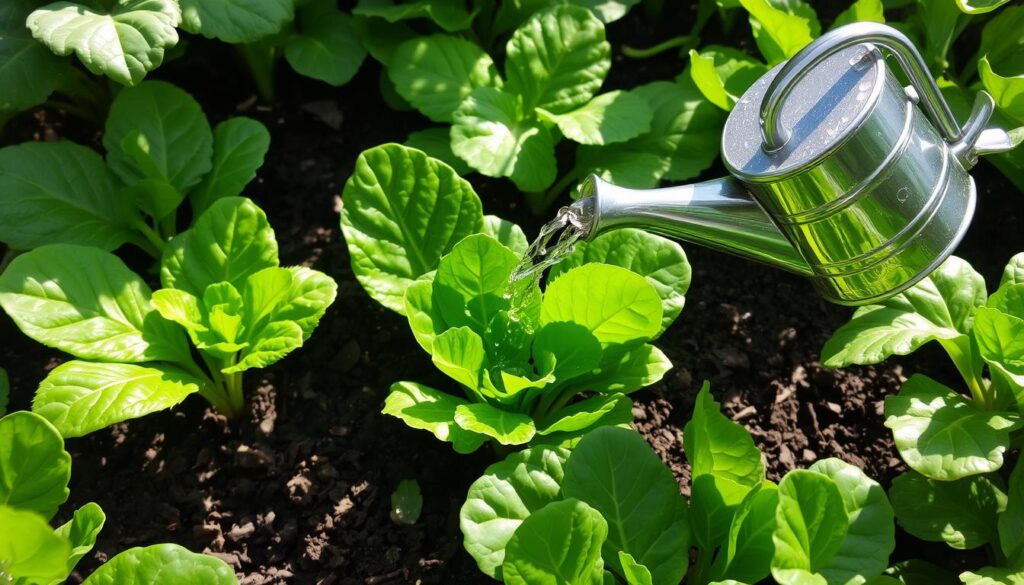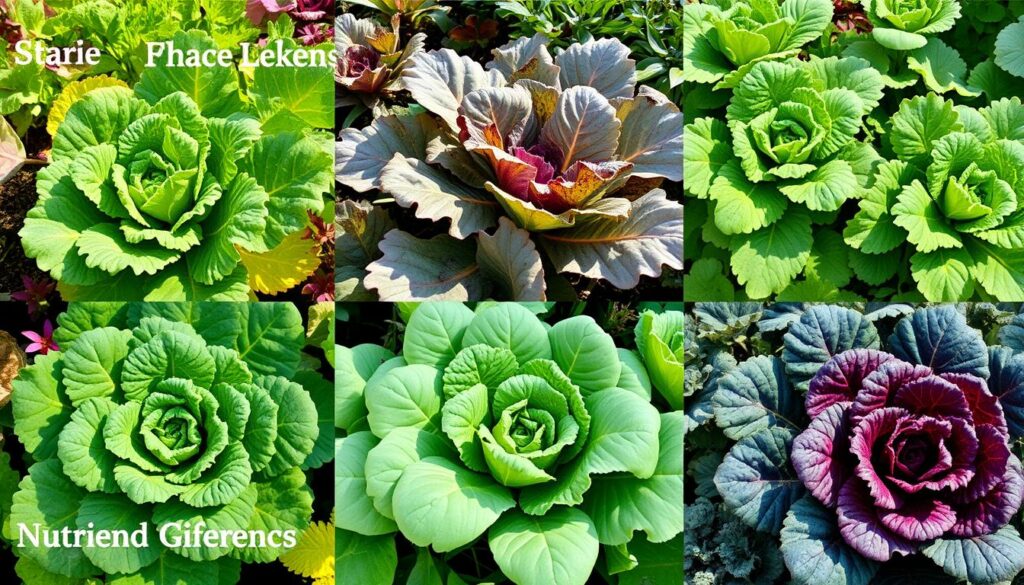I’m excited to share my gardening tips on growing leafy greens all year. You can grow these greens in any space, big or small. This guide will help you grow a lot of greens for tasty salads and meals.
Key Takeaways
- Learn how to grow a variety of leafy greens for a continuous harvest
- Discover the benefits of fresh, homegrown greens and the importance of a continuous supply
- Understand the best practices for choosing, planting, and maintaining leafy greens
- Explore techniques like succession planting and interplanting for a sustained harvest
- Gain valuable insights into watering, fertilizing, and managing pests and diseases
Introduction to Growing Leafy Greens
Leafy greens are key to a healthy diet, packed with vitamins, minerals, and antioxidants. Growing your own leafy greens means enjoying fresh, nutrient-rich salads from homegrown greens. We’ll look at why fresh produce matters and the perks of continuous harvesting.
Importance of Fresh, Homegrown Greens
Homegrown leafy greens taste better and are more nutritious than store-bought ones. Growing your own lets you control the environment, avoiding pesticides and preservatives. The taste and color of homegrown greens are amazing, boosting your health.
Benefits of Continuous Harvesting
Growing leafy greens means a steady supply all season. Continuous harvesting lets you pick greens often, not just once. This way, you get a constant flow of nutrient-rich salads and make the most of your garden.
Continuous harvesting also helps your plants grow new leaves. This keeps them healthy and gives you plenty of homegrown greens. It’s especially good for leafy greens, which grow fast and like regular picking.
“Growing your own leafy greens is a game-changer for your health and culinary experience. The fresh, vibrant flavors and the ability to control the growing process make homegrown greens a true delight.”
Choosing the Right Leafy Greens
Not all leafy greens are the same when it comes to continuous harvests. To keep your garden full of fresh greens, pick the right types for your area. Here are some top picks for growing greens all season long.
Lettuce is a great choice for ongoing harvests. Try romaine, butterhead, and oakleaf for different tastes and textures. These greens do well in cooler weather and can be planted over and over again.
Kale is packed with nutrients and can handle cold weather. Curly kale and lacinato (dinosaur) kale are perfect for multiple harvests.
Spinach offers a mild taste and soft leaves. Opt for semi-savoy or savoy-type spinach for greens that can be picked again and again.
Swiss chard is a leafy green superstar. It comes in vibrant colors and has a strong texture. Rainbow chard and Bright Lights are both beautiful and full of nutrients.
When picking greens for continuous harvests, think about growth rate, cold tolerance, and leaf texture. By choosing wisely, you’ll have a constant supply of fresh greens all season.
| Leafy Green Variety | Best Features for Continuous Harvest |
|---|---|
| Romaine Lettuce | Sturdy leaves, slow to bolt, regrows well |
| Kale | Cold-hardy, nutritious, can be harvested multiple times |
| Spinach | Tender leaves, easy to grow, regrows quickly |
| Swiss Chard | Vibrant colors, hardy texture, excellent for continuous harvest |
Preparing Your Growing Space
Choosing the right spot to grow leafy greens is very important. Whether you use raised beds or containers, knowing what your soil needs is crucial. This ensures your greens grow well.
Raised Beds or Containers
Raised beds have many benefits. They help with drainage, soil quality, and make it easier to plant and harvest. They also keep pests and weeds away. If you don’t have much space, growing in containers is a great option. Containers let you grow greens on patios, balconies, or even inside.
Soil Requirements
- Leafy greens need soil that drains well and is rich in nutrients. The pH should be slightly acidic, between 6.0 and 6.8.
- Add compost or aged manure to the soil. This improves its fertility and ability to hold water.
- The soil should have enough organic matter. This helps keep moisture in and provides nutrients for your greens.
| Soil Characteristic | Ideal Range for Leafy Greens |
|---|---|
| pH | 6.0 – 6.8 |
| Organic Matter | 3 – 5% |
| Nitrogen (N) | 0.5 – 1.0% |
| Phosphorus (P) | 0.2 – 0.4% |
| Potassium (K) | 0.3 – 0.6% |
By knowing what your soil needs and picking the best growing space, you’re set. You’ll soon have a lot of fresh, healthy leafy greens to enjoy.
Planting Techniques for Continuous Harvest
To get a lot of leafy greens, I’ll share my best tips for succession planting and interplanting. These methods will make your garden space work better. You’ll always have fresh, tasty greens all season.
Succession Planting
Planting your leafy greens in successions is key. This means planting new seeds or transplants every 2-4 weeks, based on your area’s weather. This way, as one batch is ready to pick, another is growing. Great succession planting leafy greens include spinach, arugula, and some lettuce types.
Interplanting and Companion Planting
Another smart move is interplanting leafy greens with other plants. It uses your space well and can keep pests away with companion planting for leafy greens. For instance, radishes or marigolds near your greens can keep aphids and other pests off.
Using these planting strategies, you’ll have a constant flow of fresh, healthy leafy greens. Your salads, wraps, and smoothies will be even better!
“Continuous harvesting is the key to getting the most out of your leafy green crops. Succession planting and interplanting are game-changers for any edible garden.”
How to Grow Leafy Greens for a Continuous Harvest
Growing leafy greens for a continuous harvest is a great way to have fresh, healthy greens all season. By learning the best ways to grow them, you can always have tasty leaves for your meals.
Succession planting is key for a continuous harvest. This means planting seeds often so you always have new greens. It also stops your greens from going to seed too fast.
Interplanting and companion planting are also good leafy green cultivation techniques. Mixing different greens and plants helps your harvest last longer. Companion plants can also keep pests away and add nutrients to your greens.
To keep your greens growing well, watch their water and fertilizer needs. Keep the soil moist and use organic fertilizer regularly. This will help your greens stay healthy and productive.
Harvesting Techniques for Continuous Harvest
The “cut and come again” method is a big help for growing leafy greens for continuous harvest. Instead of taking the whole plant, just cut the outer leaves. This lets the plant grow more leaves, giving you a steady supply of greens.
| Leafy Green Variety | Ideal Harvest Frequency |
|---|---|
| Kale | Every 7-10 days |
| Lettuce | Every 10-14 days |
| Bok Choy | Every 14-21 days |
By using these leafy green cultivation techniques and harvesting methods, you can have a steady supply of fresh greens all season.
“The key to a continuous harvest of leafy greens is to keep them growing and producing new leaves. With the right techniques, you can enjoy a bountiful supply all season long.”
Watering and Fertilizing
Proper watering and fertilizing are key for healthy leafy greens. The right watering and fertilizers help you get fresh, nutritious greens all season.
Watering Schedules for Leafy Greens
Leafy greens need steady moisture to grow well. Aim for a watering schedule that keeps them moist but not soggy. Water them every 2-3 days, giving about 1 inch of water weekly. Adjust this based on soil, weather, and how fast they grow.
- Water in the morning or evening to minimize evaporation.
- Use a soaker hose or drip irrigation system to deliver water directly to the soil, reducing waste.
- Monitor soil moisture regularly and water when the top inch of soil becomes dry.
- Avoid letting the soil become completely dry or waterlogged, as either can stress the plants.
Fertilizing Leafy Greens
Leafy greens love to eat and need regular food. Use a balanced, slow-release organic fertilizer or compost. Follow the manufacturer’s instructions, usually every 4-6 weeks when they’re growing.
| Nutrient | Importance for Leafy Greens |
|---|---|
| Nitrogen (N) | Promotes lush, green foliage growth. |
| Phosphorus (P) | Supports root development and overall plant health. |
| Potassium (K) | Enhances disease resistance and stress tolerance. |
Stick to a watering schedule and use the right fertilizers. This way, your leafy greens will get the nutrients they need for a constant, plentiful harvest.

Pest and Disease Management
As a passionate gardener, I know how hard it is to keep leafy greens healthy. But, with the right steps, you can manage pests and diseases. This way, you can enjoy a full harvest. I’ll share my knowledge on common problems and how to prevent them.
Aphids, powdery mildew, and downy mildew are big problems for leafy greens. Aphids harm plants, while mildew causes color changes and slow growth. To fight these, use organic pest control for leafy greens like ladybugs or neem oil. Also, keep air moving, water plants at the base, and change where you plant to stop diseases.
| Common Pests | Symptoms | Organic Control Methods |
|---|---|---|
| Aphids | Curled, discolored leaves; sticky residue | Introduce ladybugs, apply neem oil |
| Powdery Mildew | White, powdery growth on leaves | Increase air circulation, apply baking soda solution |
| Downy Mildew | Yellow, water-soaked spots on leaves | Improve drainage, apply copper-based fungicide |
By watching closely and using these methods, your leafy green garden will stay healthy. A bit of work and the right organic pest control for leafy greens and disease prevention techniques will help you have a constant, plentiful harvest.
Harvesting Leafy Greens
To get the most from your leafy greens, learn how to harvest and store them right. These skills will help you have a steady supply of fresh greens all season.
Harvesting Techniques
Timing is everything when harvesting leafy greens. The best time is in the morning, when leaves are crisp and plants are full of water. Here are some tips for efficient leafy green harvesting:
- Use clean, sharp scissors or pruners to snip the leaves, being careful not to damage the plant’s stems.
- Harvest the outer, mature leaves first, leaving the inner, younger leaves to continue growing.
- Cut the leaves at an angle, about an inch above the soil, to encourage regrowth.
- Handle the leaves gently to avoid bruising or tearing, which can lead to faster spoilage.
Storing and Preserving
Keeping your leafy greens fresh is key. Here are some ways to do it:
- Store unwashed leaves in a perforated plastic bag or airtight container in the refrigerator for up to a week.
- Wash the leaves thoroughly and pat them dry before storing to prevent moisture buildup and spoilage.
- Freeze leafy greens by blanching them in boiling water for a minute, then quickly cooling them in an ice bath. Drain, pat dry, and store in airtight bags or containers.
- Dehydrate leafy greens by spreading them in a single layer on a baking sheet and placing them in a warm oven or food dehydrator until crisp.
By learning how to harvest leafy greens, use leafy green harvesting techniques, and store and preserve leafy greens, you can enjoy fresh greens all year.
Troubleshooting Common Issues
Growing leafy greens can be rewarding, but gardeners may face challenges. From troubleshooting leafy green issues to solving common problems, this section offers practical solutions. It helps you overcome obstacles and enjoy a continuous harvest of fresh greens.
One common issue is bolting, where plants flower early and taste bitter. This usually happens due to heat or drought. To prevent it, keep your greens moist and provide partial shade when it’s hot.
Yellowing leaves can be caused by many things, like nutrient deficiencies or pests. Start by checking the soil pH and adjusting it if needed. Also, apply a balanced fertilizer and look for pests or disease.
Stunted growth is another problem, often due to poor soil or too little sunlight. Make sure your greens have good soil and enough space. They also need at least 6 hours of direct sunlight daily.
“With a little troubleshooting and perseverance, you can overcome any common problems growing leafy greens and enjoy a bountiful harvest throughout the season.”
By tackling these issues and using the right solutions, you’ll have a thriving harvest of delicious leafy greens.

| Common Issue | Possible Causes | Solutions |
|---|---|---|
| Bolting | Heat stress, drought | Provide consistent moisture, partial shade |
| Yellowing Leaves | Nutrient deficiencies, pests, disease | Check soil pH, apply balanced fertilizer, inspect for pests/disease |
| Stunted Growth | Poor soil, overcrowding, insufficient sunlight | Ensure well-draining, nutrient-rich soil, proper spacing, adequate sunlight |
Conclusion
Follow the techniques and strategies in this guide to grow a continuous harvest of leafy greens. Enjoy fresh, nutritious meals all season. Homegrown salads and meals are unmatched in freshness and nutrition.
Growing your own leafy greens has many benefits. You control the growing conditions for the best quality. It’s also rewarding to watch your garden grow and feed your family with the healthiest ingredients.
Begin your leafy green garden today. With dedication and the right techniques, you’ll have a constant supply of fresh leaves. These will make your meals more vibrant and nutritious.



Leave a Reply